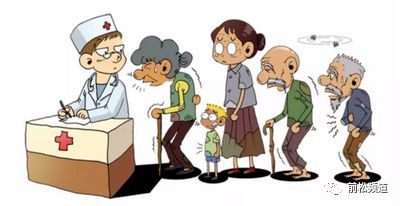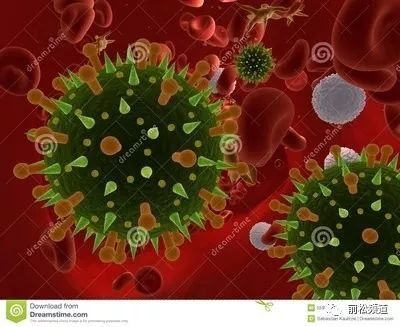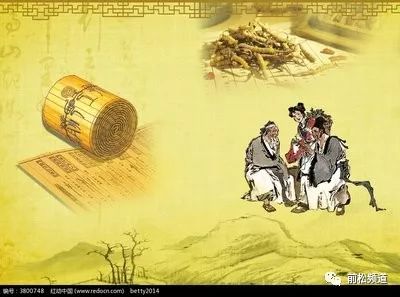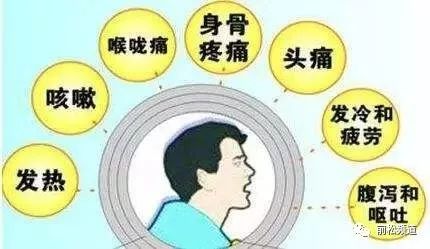
Influenza, commonly known as the flu, refers to a common external pathogenic disease characterized by symptoms such as nasal congestion, runny nose, sneezing, cough, headache, chills, fever, and general malaise caused by the invasion of wind pathogens. It is also referred to as “common cold”. When it spreads widely and symptoms are severe, it is termed “epidemic influenza”. This disease can occur in all seasons, but is most prevalent in winter and spring, with no significant differences in incidence based on age or gender, and it can sometimes present in localized outbreaks.
“Epidemic influenza” is what modern medicine refers to as influenza, an acute respiratory disease caused by the influenza virus. Its clinical characteristics include sudden onset, short duration, high fever, fatigue, and generalized muscle aches, along with mild respiratory symptoms. Influenza is highly contagious and can lead to outbreaks and pandemics. The emergence of new subtypes of the influenza A virus due to antigenic shift can cause pandemics approximately every 10-15 years, while influenza B occurs every 4-6 years, and influenza C typically presents sporadically.

Pathogen:
The pathogen is the influenza virus, which belongs to the RNA virus family, spherical in shape, with a diameter of 80-120 nm. The central nucleoprotein has subtype specificity; the inner membrane protein of the envelope also has subtype specificity; the outer layer is lipid, with hemagglutinin (HA) and neuraminidase (NA) that exhibit subtype and variant specificity. Based on the antigenicity of the nucleoprotein, influenza viruses are classified into three types: A, B, and C.
Modern Medical Pathology:
The influenza virus is primarily transmitted to the respiratory tract via airborne droplets. The virus’s neuraminidase destroys neuraminic acid, leading to the hydrolysis of mucin and exposing glycoprotein receptors, allowing the virus to enter the cells. The viral nucleoprotein binds to the epithelial cell nucleoprotein, forming soluble RNA-type antigens in the nucleus, which then permeate into the cytoplasm. The replication of progeny viruses further spreads the infection, causing an inflammatory response. Clinically, this can lead to fever, muscle pain, and leukopenia, resembling systemic toxic syndrome, but does not result in viremia.
During the course of uncomplicated influenza, ciliated epithelial cells undergo degeneration, necrosis, and shedding. After two weeks, the ciliated epithelial cells regenerate and repair. Influenza virus pneumonia is characterized by lung congestion and edema. Hemorrhagic secretions are present in the trachea and bronchi; focal hemorrhage, edema, and cellular infiltration occur in the submucosa; alveolar cavities contain fibrin and exudate, presenting the pathological features of serous hemorrhagic bronchopneumonia.

Traditional Chinese Medicine Etiology and Pathogenesis Analysis:
According to Traditional Chinese Medicine (TCM), influenza is caused by wind pathogens invading the lung and defensive qi when the body’s ability to resist pathogens is insufficient. During the four seasons, abnormal climatic conditions, such as cold in spring or heat in summer, can facilitate the invasion of wind pathogens, leading to influenza, including epidemic influenza. Although wind pathogens are the primary cause of influenza, they are often accompanied by other factors. Clinically, the most common patterns are wind-cold and wind-heat. Additionally, seasonal heat, dampness, and dryness can also contribute to the disease, leading to various mixed patterns. Besides the invasion of wind pathogens, the condition is also related to body deficiency and individual constitution. Phlegm-heat in the lungs can also predispose one to this disease. The primary location of wind pathogen invasion is the lung and defensive qi, while epidemic influenza tends to present with more pronounced systemic symptoms due to the severity of the invading pathogens. Elderly and weak individuals have a lower resistance to external pathogens, which can penetrate deeper and lead to other diseases. This condition is generally characterized by excess patterns, while deficiency patterns may present as a combination of deficiency and excess.

Clinical Manifestations:
The incubation period for this disease is 1-3 days, with a minimum of just a few hours and a maximum of up to 4 days.
Uncomplicated influenza: More common. Sudden high fever, with severe systemic symptoms but mild respiratory symptoms. Symptoms include chills, fever, headache, fatigue, and generalized aches. Body temperature can reach 39-40°C. After 2-3 days, symptoms gradually improve, but nasal congestion, runny nose, sneezing, sore throat, and dry cough may remain prominent. A minority may experience mild gastrointestinal symptoms. Physical examination may reveal an acute illness appearance, flushed cheeks, mild conjunctival injection, tenderness in the eyeballs, pharyngeal congestion, and possible herpes on the oral mucosa.
Pneumonia-type influenza: Primarily occurs in patients with pre-existing heart and lung conditions or pregnant women. Clinical manifestations include persistent high fever, shortness of breath, cyanosis, paroxysmal cough, and hemoptysis. Physical examination may reveal decreased breath sounds in both lungs, with diffuse wheezing but no signs of consolidation; the course of the disease can last 3-4 weeks. If complicated by bacterial infection, it may present as bronchopneumonia or lobar pneumonia, characterized by severe cough, purulent sputum, chest pain, and signs of consolidation or focal pneumonia in the lungs.
Toxic-type influenza: Lung lesions are not prominent, but there is significant damage to the vascular and nervous systems. High fever persists, with confusion and often delirium. A minority may experience a drop in blood pressure or shock due to vascular or adrenal hemorrhage.
Others: After infection with the influenza virus, only mild fever, cough, and discomfort may occur. The course lasts 1-2 days, resembling other viral upper respiratory infections, termed mild influenza. A minority of patients may present primarily with abdominal pain and diarrhea, termed gastrointestinal influenza.
Laboratory Tests:
Blood tests: Total white blood cell count decreases, with a relative increase in lymphocytes and disappearance of eosinophils. If complicated by bacterial infection, total white blood cell count and neutrophils may increase. Immunofluorescence tests: Nasal wash samples from patients are stained with fluorescently labeled influenza virus immune serum and examined under a fluorescence microscope, which has high sensitivity and aids in early diagnosis.
Virus isolation: Inoculate the cough samples from acute phase patients into chicken embryos or allantoic fluid for virus isolation.
Serological tests: Use hemagglutination inhibition tests or complement fixation tests to measure antibodies in acute and recovery phase sera; a fourfold increase indicates a positive result, aiding in retrospective diagnosis.
Differential Diagnosis:
Epidemic meningitis: The early symptoms of meningitis often resemble influenza, but meningitis has a more pronounced seasonality and is more common in children. Early symptoms include severe headache, meningeal irritation signs, and petechiae. Cerebrospinal fluid examination can confirm the diagnosis.
Legionnaires’ disease: More common in summer and autumn. Clinically characterized by severe pneumonia, elevated total white blood cell count, and liver and kidney complications. However, mild cases may resemble influenza. Diagnosis relies on pathogen examination.
Mycoplasma pneumonia: Similar X-ray findings to pneumonia-type influenza, but this condition is generally milder. Cold agglutination tests and MG-type streptococcus agglutination tests may yield positive results.
Treatment:
Modern Medical Treatment:
Currently, there are no reliable antiviral drugs for influenza. Amantadine hydrochloride can prevent the entry of influenza A virus into cells when used early, thereby alleviating symptoms and shortening the duration of the illness. Adults can take 0.2 grams orally per day, divided into two doses. Due to its toxicity, it has not been widely used in clinical practice. If a secondary bacterial infection occurs, antibiotics should be used promptly.
TCM Differentiation and Treatment:
External Wind-Cold:
Symptoms: Nasal congestion with a heavy voice, itchy nose, sneezing, clear and thin runny nose, cough with abundant clear phlegm, possibly fever and chills, no sweating, headache, body aches, thin white tongue coating, floating tight pulse.
Treatment principle: Release the exterior with warm acrid herbs, disperse lung cold.
Formula: Jing Fang Bai Du San (Jing Jie, Fang Feng, Chai Hu, Chuan Xiong, Zhi Ke, Qiang Huo, Du Huo, Fu Ling, Jie Geng, Qian Hu, Gan Cao).
Modification: If wind-cold is more severe, add Ma Huang and Gui Zhi; if cough with phlegm is more severe, add Xing Ren and Zhe Bei Mu.
Wind-Cold with Dampness:
Symptoms: Chills with little sweating, heavy head, joint and body aches, cough with a heavy voice, nasal congestion with runny nose, white greasy tongue coating, slippery pulse.
Treatment principle: Disperse wind, eliminate dampness, and release the exterior.
Formula: Qiang Huo Sheng Shi Tang (Qiang Huo, Du Huo, Gao Ben, Fang Feng, Gan Cao, Chuan Xiong, Man Jing Zi).
Modification: If there is no sweating, add Dou Juan and Cang Zhu; if phlegm is abundant, add Ban Xia and Chen Pi.
External Wind-Heat:
Symptoms: Fever with aversion to wind, or slight aversion to cold, headache, nasal congestion with thick yellow discharge, cough with yellow phlegm, dry mouth and thirst, sore and swollen throat, red tongue with thin yellow coating, floating rapid pulse.
Treatment principle: Release the exterior with cool acrid herbs, clear heat and disperse lung heat.
Formula: Yin Qiao San (Yin Hua, Lian Qiao, Jie Geng, Bo He, Zhu Ye, Sheng Gan Cao, Jie Sui, Dan Dou Chi, Niu Bang Zi, Xian Lu Gen).
Modification: If nasal congestion and headache are prominent, add Cang Er Zi, Xin Yi Hua; if throat pain is severe, add Yuan Shen, Ma Bo, Ban Lan Gen; if thirst is severe, add Tian Hua Fen; if heat is severe, add Huang Qin.
Wind-Heat with Dryness:
Symptoms: Fever with slight aversion to wind and cold, dryness in the nasal and pharyngeal passages, cough with little or no phlegm, headache and body aches, dry mouth and thirst, red tongue with little moisture, floating rapid pulse.
Treatment principle: Disperse wind, clear heat, moisten dryness, and stop cough.
Formula: Yin Qiao San combined with Sang Xing Tang (Yin Hua, Lian Qiao, Zhu Ye, Jing Jie, Niu Bang Zi, Bo He, Dan Dou Chi, Gan Cao, Jie Geng, Lu Gen, Sang Ye, Xing Ren, Sha Shen, Xiang Bei, Zhi Zi, Li Pi).
External Cold with Internal Heat:
Symptoms: Chills without sweating, body aches, irritability, cough with shortness of breath, hoarse voice, sore throat, red tongue tip with slight yellow coating, rapid pulse.
Treatment principle: Disperse lung cold, clear heat, and stop cough.
Formula: Ma Huang, Xing Ren, Shi Gao, Gan Cao Tang.
Modification: If internal heat is more severe, add Huang Qin, Zhi Zi, Lu Gen; if cough is severe, add Qian Hu, Sang Bai Pi; if body aches are prominent, add Qiang Huo, Du Huo.
External Dampness:
Symptoms: Slight fever with aversion to wind and cold, little sweating, heavy and painful limbs, heavy and congested head, cough with sticky phlegm, nasal congestion with runny nose, chest discomfort, nausea and vomiting, sticky mouth, no thirst or little thirst, irritability, or constipation, red tongue with yellow greasy coating, slippery rapid pulse.
Treatment principle: Clear summer heat, eliminate dampness, disperse lung and release the exterior.
Formula: Wu Wei Xiang Ru Yin with modifications (Xiang Ru, Bian Dou, Hou Po, Fu Ling, Gan Cao, Qing Hao, Shan Zhi, Xian He Ye).
Modification: If exterior dampness is more severe, with heavy limbs and head, add Dou Juan, Huo Xiang, Peilan; if internal dampness is more severe, with significant nausea and vomiting, add Cang Zhu, Bai Dou Kou, Qing Ban Xia, Chen Pi; if internal heat is severe with short red urine, add Liu Yi San.
Qi Deficiency Cold:
Symptoms: Fever with aversion to cold, body aches, cough, nasal congestion, spontaneous sweating, fatigue, shortness of breath, pale tongue with white coating, floating weak pulse.
Treatment principle: Tonify qi, release the exterior, and harmonize the nutritive and defensive qi.
Formula: Shen Su Yin (Dang Shen, Gan Cao, Fu Ling, Su Ye, Ge Gen, Ban Xia, Chen Pi, Qian Hu, Jie Geng, Mu Xiang, Zhi Ke, Sheng Jiang, Da Zao).
If there is a history of qi deficiency with spontaneous sweating and recurrent colds, use Yu Ping Feng San for prevention.
Yang Deficiency Cold:
Symptoms: Severe aversion to cold with mild fever, headache and body aches, spontaneous sweating, cough with white phlegm, nasal congestion with clear discharge, pale complexion, cold limbs, low voice, pale swollen tongue with white coating, deep weak pulse.
Treatment principle: Assist yang, release the exterior, disperse lung and stop cough.
Formula: Ma Huang, Fu Zi, Xi Xin Tang.
Modification: If cough with abundant phlegm, add Xing Ren and Ban Xia.
Blood Deficiency Cold:
Symptoms: Mild fever with aversion to cold, no sweating, headache, pale complexion, pale lips and nails, palpitations, dizziness, pale tongue with white coating, thin pulse.
Treatment principle: Nourish blood, release the exterior, and disperse wind and cold.
Formula: Qi Wei Yin (Cong Bai, Dou Chi, Ge Gen, Sheng Jiang, Sheng Di, Mai Dong).
Modification: If thirsty with dry throat, add Tian Hua Fen and Lu Gen; if heat is severe, add Yin Hua, Lian Qiao, Huang Qin.
Yin Deficiency Cold:
Symptoms: Mild fever with aversion to wind and cold, headache without sweating, dizziness and irritability, dry mouth and throat, hot palms and soles, cough with little phlegm, red tongue with thin rapid pulse.
Treatment principle: Nourish yin, release the exterior, and disperse wind and disperse lung.
Formula: Jia Jian Wei Rui Tang (Yu Zhu, Cong Bai, Dou Chi, Jie Geng, Bo He, Bai Wei, Gan Cao, Da Zao).
Modification: If irritability and thirst are severe, add Huang Lian, Zhu Ye, Tian Hua Fen; if cough with dry throat and unproductive phlegm, add Niu Bang Zi, She Gan, Gua Lou Pi; if cough with chest pain and blood-streaked phlegm, add fresh Mao Gen, Sheng Pu Huang, Ou Jie; if constipation, add Sheng Di and Xuan Shen.
Single Prescription Verification:
1. Da Qing Ye, Ban Lan Gen, and Guan Zhong, each 30 grams, decocted in water to drink as tea. This can prevent and treat influenza.
2. Guan Zhong, Zi Su, and Jing Jie, each 10 grams, Gan Cao 3 grams, decocted and taken in one dose, for three consecutive days. This can prevent and treat wind-cold influenza in winter and spring.
3. Chan Can Jie Biao Tang: Chan Tui, Jiang Can, Ban Lan Gen, Lian Qiao, Sang Ye, each 10 grams, Bo He 9 grams, Lu Gen 15 grams. Soak the above herbs in water for 30 minutes, boil for 15 minutes, and mix the decoction. Depending on the severity of the condition, take 1-2 doses daily, divided into 2-4 times warm. Suitable for wind-heat influenza.
4. Huo Xiang and Peilan, each 5 grams, Bo He 2 grams, boiled in soup as a beverage. This can prevent and treat summer heat-damp influenza.
5. Summer influenza compound: Xiang Ru 6 grams, Huo Xiang, Peilan, and Hou Po, each 10 grams, roasted Kuan Pi Ye 12 grams, Duck’s Foot Grass 15 grams. Each dose is soaked in an appropriate amount of water for half an hour, boiled for 10 minutes, filtered to take the medicinal liquid, and taken warm in two doses daily. Suitable for summer heat influenza.
6. Lan Di Tang: Ban Lan Gen 50 grams, Sheng Di 50 grams, Cun Dong 20 grams, Zhi Mu 20 grams, Sang Ye 20 grams, Jie Geng 15 grams, Chan Tui 15 grams. Take 1 dose daily, decocted twice, divided into 2-3 warm doses, for three consecutive days. Suitable for yin deficiency influenza.
External Treatment Methods:
Wind-Cold Influenza:
1. Green onion tops and ginger, each 30 grams, salt 6 grams, and 1 cup of white wine. Mash the first three ingredients into a paste, mix with wine, wrap in gauze, and apply to the back, palms, and knees. After applying once, let the patient rest, and sweating usually occurs after about 30 minutes.
2. Bai Zhi 3 grams, Bing Pian 0.6 grams, ground into fine powder, sieved, stored in a sealed bottle. When needed, take an appropriate amount of the powder, wrap it in cotton, and insert it into one nostril, alternating sides for 30 minutes, three times a day, for a 3-day course.
Wind-Heat Influenza:
1. Sang Ye, Ju Hua, and Bo He, each 10 grams, Lian Qiao 20 grams, Sheng Jiang 10 grams, Gui Zhi 6 grams, and green onion 1 stalk. Crush all the herbs and divide into two bags, boil in water for 20 minutes. First, take one bag to apply to the neck, shoulders, and back, and when it cools, switch to the other bag, alternating for 30-40 minutes, twice daily for a 3-day course. The juice can also be used to wash various body parts to enhance efficacy.
2. Yin Hua 4 grams, Lian Qiao 4 grams, Jie Geng 2.4 grams, Niu Bang Zi 2.4 grams, Dan Dou Chi 2 grams, Gan Cao 2 grams, Zhu Ye 1.6 grams. Grind all the herbs into fine powder, sieve, take an appropriate amount of the powder, wrap it in gauze, and apply to the Shen Que point, securing it. Each application lasts 4-6 hours, twice daily.
Acupuncture Therapy:
1. Body acupuncture therapy:
Acupoints: Feng Chi, Da Zhui, Qu Chi, He Gu, etc.
Additional points: For wind-cold influenza, add Feng Men and Fei Shu; for wind-heat influenza, add Yu Ji and Wai Guan; for summer damp influenza, add Zhi Gu; for qi deficiency influenza, add Qi Hai and Zu San Li; for yang deficiency influenza, add Bai Hui and Guan Yuan; for blood deficiency influenza, add Xue Hai and San Yin Jiao; for yin deficiency influenza, add Tai Xi.
2. Ear acupuncture therapy:
Acupoints: Lung, Trachea, Nasal cavity, Spleen, San Jiao, Ear apex, etc.
After local disinfection, puncture the ear apex to induce bleeding, select 2-3 other points for simultaneous needling on both sides, using a twirling method, leaving the needles for 10-20 minutes.
3. Electroacupuncture:
Acupoints: Da Zhui, Qu Chi, He Gu, Feng Chi, etc. Select 2 points each time, insert fine needles, and after achieving needle sensation, apply electrical stimulation, choosing appropriate waveforms and frequencies until the patient can tolerate a numb and swollen sensation, with each session lasting 10-20 minutes.
4. Bloodletting therapy:
Acupoints: Chi Ze, Wei Zhong, Shao Shang, Da Zhui, Ear apex, Ear lobe, etc. Puncture Da Zhui to induce bleeding, and apply cupping for 5-10 minutes; for Chi Ze and Wei Zhong, use a three-edged needle to puncture and induce bleeding until it stops; for Shao Shang, Ear apex, and Ear lobe, puncture to induce a few drops of blood.
5. Skin needle therapy:
For wind-cold influenza, target the sides of the spine, elbow pits, and fish regions; for wind-heat influenza, target the chest and back, Feng Chi, Da Zhui, He Gu, Qu Chi. Apply moderate to strong stimulation, treating 2-3 times daily.
6. Head needle therapy:
Target sensory areas and thoracic areas, inserting needles horizontally, twisting for 1-3 minutes, and leaving the needles for 15 minutes.
7. Light needle therapy:
Acupoints: Da Zhui, Feng Chi, Feng Men, Ge Shu, He Gu, Qu Chi, Yu Ji, Wai Guan.
Select 2-4 points each time, using a helium-neon laser to irradiate, with a power of generally 10-30 milliamps, at a distance of 20-30 millimeters, once daily, and for severe cases, twice daily, with each point irradiated for 2-5 minutes.
Tui Na Therapy:
Techniques: Thumb pressure on Feng Chi, Feng Fu, Da Zhui, Wai Guan, He Gu, Qu Chi, and shoulder kneading.
For wind-cold influenza, use thumb Zen push technique from the Yao Zhu point along the foot Tai Yang meridian to the Tian Zhu point to clear the foot Tai meridian, relieve headache, open lung passages, and massage Lie Que to disperse lung and stop cough, assisting sweating and releasing the exterior; for wind-heat, use thumb Zen push technique from the Yin Tang point along the Du meridian to the Shen Ting point to dispel wind-heat, then use thumb wiping technique from the Yin Tang point along the forehead to both sides to disperse wind and heat, open meridians, and relieve pain.

Prevention:
When there are continuous clinical cases of typical influenza, timely reporting and isolation of patients should be conducted.
Herbal prevention: Dried Huo Xiang, dried Peilan, and dried Bo He can be decocted in water, or Yin Qiao Jie Du Wan can be taken orally.
During influenza epidemic seasons, vinegar fumigation can be used for air disinfection. Close all doors and windows tightly, using 5ml of vinegar per cubic meter of space, mixed with an equal amount of water, placed in a clay or aluminum pot on the stove, and use steam to fumigate the room for more than half an hour to achieve disinfection and prevention.


